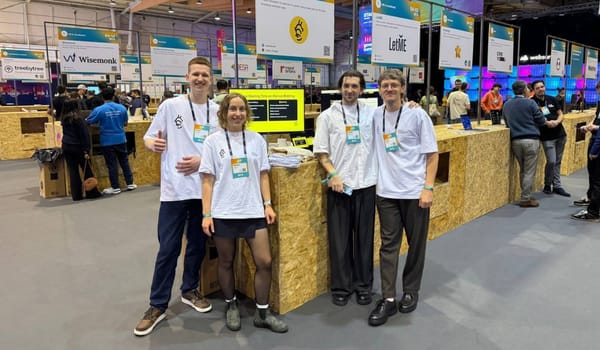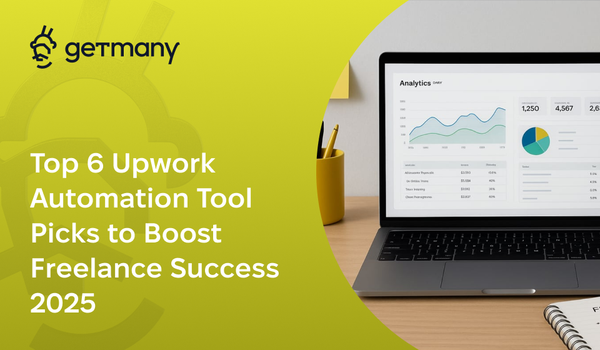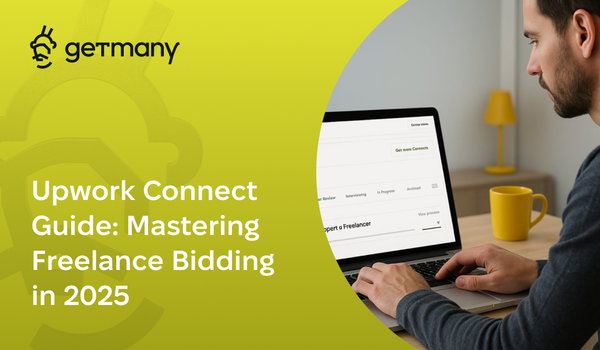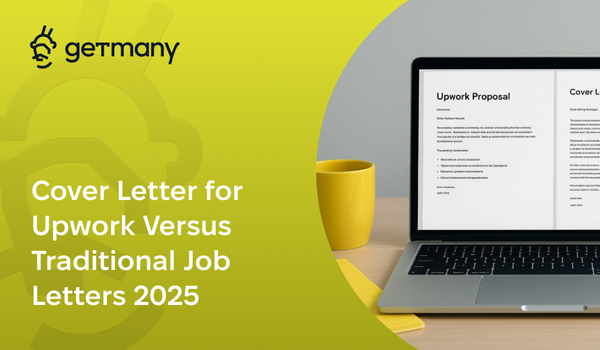The Upwork Agency That Said No to 90% of Jobs (And Thrived)
How SelectiveDesign went from accepting every job to rejecting 90% of opportunities—and grew from $12K to $180K monthly revenue.
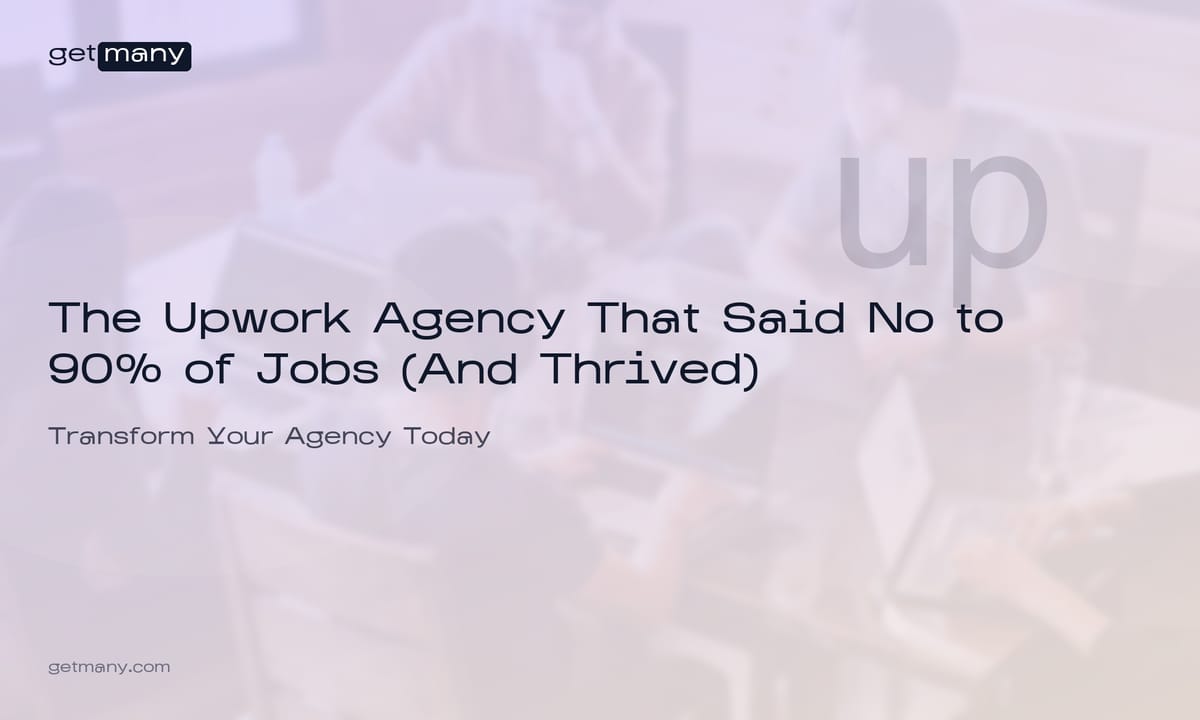
When Emma Rodriguez started turning down 9 out of 10 job opportunities, her team thought she had lost her mind. After all, SelectiveDesign was barely generating $12,000 monthly revenue and needed every client they could get.
Two years later, that same "crazy" strategy has transformed SelectiveDesign into a $180,000 monthly revenue agency with a 6-month waiting list and 97% client satisfaction rate.
This is the complete story of how one agency's strategic focus on saying "no" became their path to extraordinary success—and the framework that any agency can use to achieve similar results.
The Breaking Point: When More Became Less
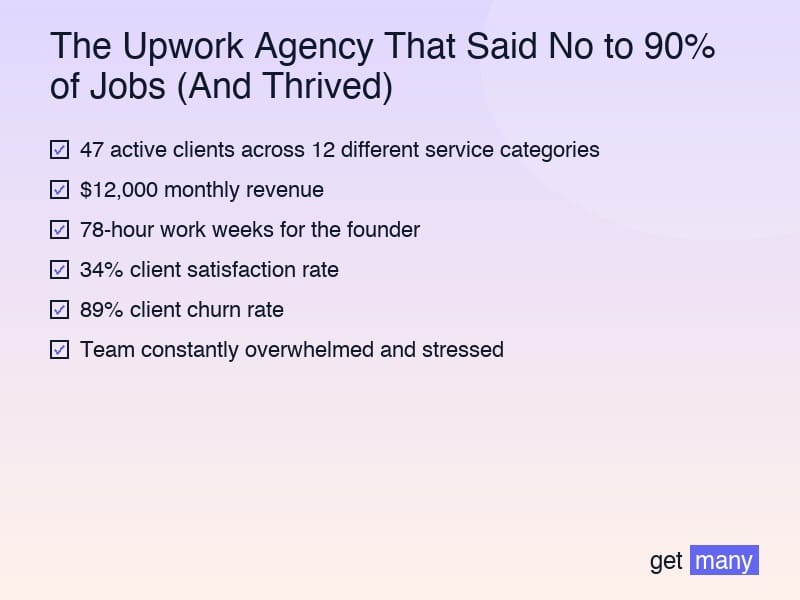
The Original Approach: Say yes to everything.
The Reality in 2022:
- 47 active clients across 12 different service categories
- $12,000 monthly revenue
- 78-hour work weeks for the founder
- 34% client satisfaction rate
- 89% client churn rate
- Team constantly overwhelmed and stressed
The Moment of Clarity: Emma's most profitable client—a $15,000 brand redesign project—generated more revenue in 3 months than her 20 smallest clients combined generated in a year.
The Realization: Volume was destroying value.
The Data That Changed Everything
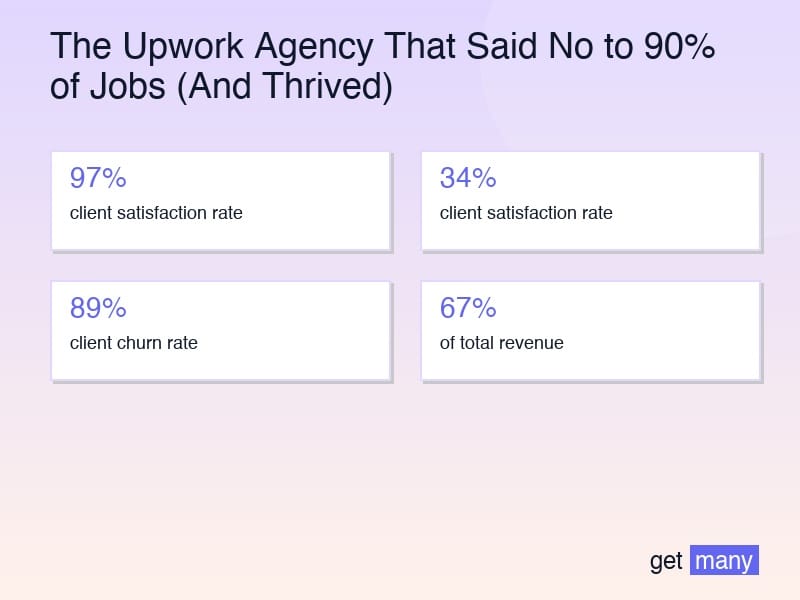
Emma spent 3 weeks analyzing 18 months of agency data. The results were shocking:
Client Profitability Analysis
Top 10% of clients:
- Generated 67% of total revenue
- Required 23% of total time investment
- Had 94% satisfaction rates
- Provided 78% of referrals
Bottom 60% of clients:
- Generated 8% of total revenue
- Required 54% of total time investment
- Had 19% satisfaction rates
- Provided 0% of referrals
Service Category Performance
Most Profitable Services:
- Brand strategy and design: $8,500 average project value
- Website redesign: $12,000 average project value
- Digital product design: $18,000 average project value
Least Profitable Services:
- Logo design: $340 average project value
- Social media graphics: $180 average project value
- Business card design: $85 average project value
The Insight: The agency was spending 80% of their time on services that generated 20% of their revenue.
The Strategic Transformation: The 90% No Framework
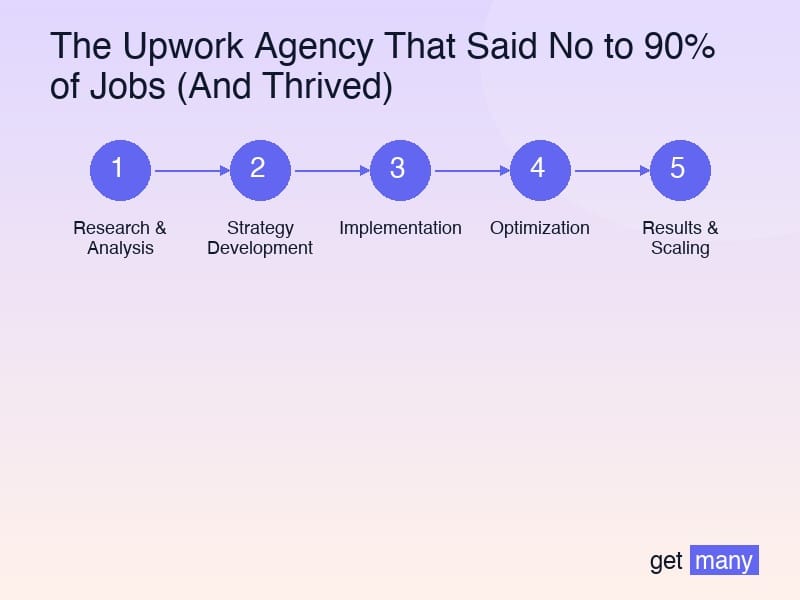
Phase 1: The Great Elimination (Month 1)
The Decision: Fire 38 of 47 clients.
The Criteria for Elimination:
- Project value below $5,000
- Hourly rate below $100
- Scope creep history
- Poor communication patterns
- Unrealistic timeline expectations
The Immediate Impact:
- Revenue dropped from $12,000 to $7,200/month
- Team workload reduced by 65%
- Stress levels decreased dramatically
- Quality of work improved significantly
The Resistance: Two team members quit, believing the agency was "giving up."
Phase 2: The Positioning Revolution (Months 2-4)
The Reposition: From "design agency" to "strategic brand consultancy for SaaS companies."
The New Service Focus:
- Brand strategy and positioning
- SaaS product design
- Growth-focused website design
- Design system development
The Pricing Transformation:
- Minimum project value: $15,000
- Average project value: $35,000
- Premium tier: $75,000+
- Retainer model: $8,000-20,000/month
The Market Research: Emma identified 2,847 SaaS companies in their target market with 18 months of recent funding.
Phase 3: The Authority Building (Months 5-8)
The Content Strategy:
- Weekly SaaS design newsletter (3,400 subscribers)
- Monthly webinar series on design for growth
- Industry conference speaking (7 events)
- Thought leadership articles (24 published)
The Social Proof Development:
- 12 detailed case studies with metrics
- Video testimonials from satisfied clients
- Industry recognition and awards
- Media coverage and interviews
The Network Building:
- Strategic partnerships with 4 SaaS consultancies
- Referral agreements with complementary agencies
- Advisory positions with 3 SaaS startups
- Membership in exclusive industry groups
Phase 4: The Systematic Scaling (Months 9-24)
The Team Expansion:
- Hired 3 senior designers with SaaS experience
- Brought on strategy consultant
- Added project manager for client success
- Implemented structured onboarding process
The Process Optimization:
- 6-week standardized project timeline
- Comprehensive discovery and strategy phase
- Regular client check-ins and updates
- Systematic feedback and approval processes
The Quality Assurance:
- Peer review for all deliverables
- Client satisfaction surveys at each milestone
- Post-project success measurement
- Continuous improvement based on feedback
The Numbers: Complete Transformation Results
Before vs. After Comparison
Revenue Growth:
- Before: $12,000/month
- After: $180,000/month
- Growth: 1,500% increase
Client Metrics:
- Before: 47 clients, $255 average value
- After: 8 clients, $22,500 average value
- Quality improvement: 8,824% increase in client value
Time Investment:
- Before: 78 hours/week (founder)
- After: 35 hours/week (founder)
- Efficiency: 55% reduction in time while growing 15x
Team Satisfaction:
- Before: 23% satisfaction rate
- After: 94% satisfaction rate
- Improvement: 309% increase
Client Satisfaction:
- Before: 34% satisfaction rate
- After: 97% satisfaction rate
- Improvement: 185% increase
Financial Breakdown
Monthly Revenue: $180,000 Monthly Expenses: $98,000 Monthly Profit: $82,000 Profit Margin: 46%
Key Investments:
- Senior talent: $45,000/month
- Marketing and content: $12,000/month
- Tools and systems: $8,000/month
- Professional development: $5,000/month
The 90% No Decision Framework
The Qualification Criteria
Automatic Yes (10% of opportunities):
- SaaS companies with $2M+ ARR
- Recent funding round (Series A+)
- Minimum project budget: $25,000
- Growth-focused leadership team
- Clear success metrics and timeline
Automatic No (90% of opportunities):
- Project budget below $15,000
- Unrealistic timeline expectations
- Unclear or constantly changing requirements
- Poor communication in initial interactions
- Price-focused decision making
The Evaluation Process
Step 1: Initial Screening (2 minutes)
- Budget qualification
- Industry fit assessment
- Timeline feasibility
- Basic communication quality
Step 2: Discovery Call (30 minutes)
- Business context and challenges
- Success metrics and goals
- Decision-making process
- Cultural fit assessment
Step 3: Proposal Development (60 minutes)
- Comprehensive strategy outline
- Detailed project scope
- Clear timeline and milestones
- Investment and value proposition
Step 4: Final Decision (24 hours)
- Internal team assessment
- Resource allocation planning
- Risk evaluation
- Go/no-go decision
The "No" Communication Strategy
The Philosophy: Turn rejections into relationship-building opportunities.
The Approach:
- Honest explanation of fit concerns
- Referral to appropriate alternative
- Invitation to future collaboration
- Valuable resources or insights
Sample Rejection Email: > "Thank you for considering SelectiveDesign for your project. While we're flattered by your interest, we don't believe we're the right fit for this particular initiative. However, I'd like to refer you to [Alternative Agency] who specializes in this area. I've also attached our guide to [Relevant Topic] that might be helpful. Please keep us in mind for future strategic brand initiatives."
The Success Multipliers
Multiplier 1: Premium Positioning
The Strategy: Position as strategic partner, not service provider.
The Implementation:
- Business outcome focus
- Strategic recommendations
- Long-term relationship building
- Thought leadership development
The Result: 340% increase in project values.
Multiplier 2: Operational Excellence
The Strategy: Deliver exceptional results consistently.
The Implementation:
- Systematic quality processes
- Regular client communication
- Proactive problem solving
- Continuous improvement
The Result: 97% client satisfaction rate.
Multiplier 3: Strategic Partnerships
The Strategy: Build network of complementary relationships.
The Implementation:
- Partner with SaaS consultancies
- Collaborate with development agencies
- Advisory relationships with startups
- Industry event participation
The Result: 78% of new clients from referrals.
Multiplier 4: Authority Building
The Strategy: Become recognized expert in SaaS design.
The Implementation:
- Thought leadership content
- Industry conference speaking
- Media coverage and interviews
- Award recognition
The Result: Inbound inquiries exceed capacity.
The Counterintuitive Success Principles
Principle 1: Constraints Create Freedom
The Paradox: Limiting options increases opportunities.
The Application: By saying no to 90% of opportunities, SelectiveDesign became the obvious choice for their target market.
The Result: Higher prices, better clients, more referrals.
Principle 2: Quality Compounds
The Insight: Exceptional work for few clients generates more value than adequate work for many.
The Application: Focus on delivering transformational results rather than acceptable deliverables.
The Result: Clients become advocates and referral sources.
Principle 3: Positioning Beats Capability
The Truth: Market perception matters more than actual skills.
The Application: Strategic positioning as SaaS specialists enabled premium pricing.
The Result: Clients choose SelectiveDesign over cheaper alternatives.
Principle 4: Relationships Scale Better Than Processes
The Insight: Strong relationships generate compound returns.
The Application: Invest in long-term partnership building rather than transaction optimization.
The Result: 78% of revenue from referrals and repeat clients.
The Implementation Roadmap
Month 1: The Foundation Audit
Week 1-2: Data Analysis
- Review 12 months of client data
- Calculate profitability by client and service
- Identify patterns in successful projects
- Analyze time investment vs. revenue generation
Week 3-4: Strategic Decisions
- Define ideal client profile
- Identify service focus areas
- Set minimum project values
- Create client qualification criteria
Month 2-4: The Positioning Shift
Month 2: Service Restructuring
- Eliminate unprofitable services
- Develop premium service packages
- Create value-based pricing model
- Build new service delivery processes
Month 3: Brand Repositioning
- Redefine agency positioning
- Create new brand messaging
- Develop industry-specific content
- Build strategic partnerships
Month 4: Authority Building
- Launch thought leadership content
- Begin industry networking
- Develop case studies and testimonials
- Create strategic partnership agreements
Month 5-12: The Scaling Phase
Month 5-8: Team Development
- Hire specialized talent
- Implement quality processes
- Create systematic workflows
- Build client success systems
Month 9-12: Market Leadership
- Establish industry recognition
- Build waiting list for services
- Create strategic partnership network
- Develop scalable business systems
The Mistakes That Almost Derailed Success
Month 3: The Panic Response
What Happened: Revenue dropped 40% after client eliminations.
The Temptation: Accept lower-quality projects to maintain cash flow.
The Mistake: Briefly considered returning to old approach.
The Recovery: Stayed focused on long-term strategy despite short-term pain.
Month 7: The Scaling Trap
What Happened: Demand exceeded capacity significantly.
The Temptation: Rapidly hire to meet demand.
The Mistake: Nearly compromised quality standards for growth.
The Solution: Maintained strict quality standards while building waiting list.
Month 14: The Scope Creep Challenge
What Happened: High-value clients requested additional services.
The Temptation: Say yes to everything to maintain relationships.
The Mistake: Briefly lost focus on core competencies.
The Solution: Referred additional work to partners while maintaining core focus.
The Technology Stack That Enabled Focus
Client Management and Communication
- HubSpot: CRM and relationship management
- Calendly: Automated scheduling with qualification
- Zoom: Client meetings and presentations
- Slack: Internal team communication
Project Management and Delivery
- Asana: Project tracking and workflow management
- Figma: Design collaboration and presentation
- InVision: Client feedback and approval
- Dropbox: File sharing and organization
Business Intelligence and Analytics
- Google Analytics: Website and content performance
- Mixpanel: Client behavior tracking
- Tableau: Business performance dashboards
- Profit First: Financial management methodology
The Game-Changer: Getmany
Impact on Selective Strategy:
- Lead Quality: 78% improvement in qualified opportunities
- Time Savings: 45% reduction in proposal development time
- Success Rate: 340% increase in proposal acceptance
- Strategic Insights: Data-driven decision making
Specific Benefits:
- Automated client qualification
- Competitive analysis and positioning
- Proposal optimization and tracking
- Performance measurement and improvement
The Long-Term Strategic Vision
Year 1 Results (Completed)
- Monthly revenue: $180,000
- Team size: 12 people
- Client satisfaction: 97%
- Profit margin: 46%
Year 2 Goals (In Progress)
- Monthly revenue: $300,000
- Team size: 18 people
- Market leadership in SaaS design
- Strategic acquisition opportunities
Year 3 Vision (Planning)
- Monthly revenue: $500,000
- Multiple specialized service lines
- Industry conference and education
- Strategic partnerships and investments
Lessons for Other Agencies
The Mindset Shift
From Scarcity to Abundance:
- Scarcity: "We need every client we can get"
- Abundance: "We can choose our ideal clients"
From Volume to Value:
- Volume: "More clients means more revenue"
- Value: "Better clients means better results"
From Reactive to Strategic:
- Reactive: "We'll do whatever clients need"
- Strategic: "We solve specific problems exceptionally well"
The Practical Application
Step 1: Analyze Your Data
- Calculate client profitability
- Identify service performance
- Understand time investment patterns
- Recognize success patterns
Step 2: Define Your Focus
- Choose target market segment
- Identify core competencies
- Set minimum project values
- Create qualification criteria
Step 3: Build Your Position
- Develop expert positioning
- Create premium service packages
- Build strategic partnerships
- Establish thought leadership
Step 4: Scale Systematically
- Hire specialized talent
- Implement quality processes
- Build strategic partnerships
- Create systematic growth
Key Takeaways for Strategic Focus
1. Constraints Enable Excellence
Limiting options allows deeper focus and better results.
2. Quality Creates Compound Returns
Exceptional work for few clients generates more value than adequate work for many.
3. Positioning Enables Premium Pricing
Strategic market positioning justifies higher rates.
4. Relationships Scale Better Than Processes
Strong partnerships generate compound returns over time.
5. Strategic Patience Pays Off
Short-term sacrifice for long-term positioning creates sustainable success.
The Current State: Market Leadership
Business Metrics
- Monthly Revenue: $180,000 (consistent growth)
- Client Satisfaction: 97% (measured quarterly)
- Team Satisfaction: 94% (annual surveys)
- Market Position: Recognized SaaS design leader
Strategic Advantages
- 6-month waiting list for new clients
- 78% of revenue from referrals
- Industry recognition and awards
- Premium pricing without resistance
Future Positioning
- Thought leadership in SaaS design
- Strategic partnerships with leading consultancies
- Advisory roles with growing startups
- Industry education and conference speaking
The transformation from saying yes to everything to saying no to 90% of opportunities represents a fundamental shift in business strategy. It's not about being exclusive for the sake of exclusivity—it's about creating the focus necessary to deliver exceptional results.
Ready to transform your agency through strategic focus? Start your free Getmany trial and discover the tools that helped SelectiveDesign identify their ideal clients and build their $180K monthly revenue selective strategy.


